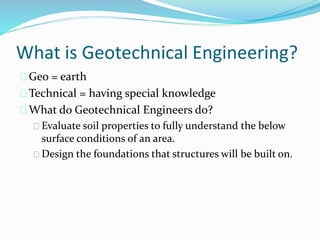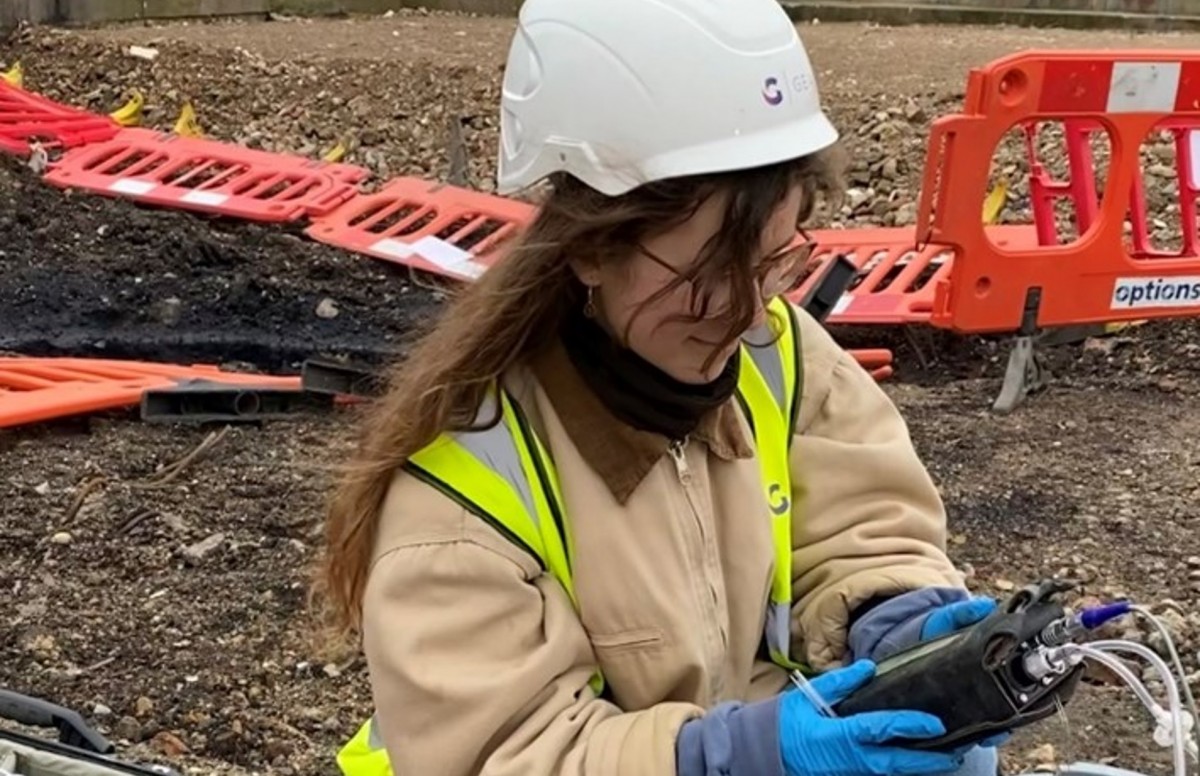The Best Guide To Geotheta
The Best Guide To Geotheta
Blog Article
The Best Guide To Geotheta
Table of ContentsThe Best Strategy To Use For GeothetaGeotheta Things To Know Before You Get ThisThe Best Strategy To Use For GeothetaA Biased View of Geotheta7 Simple Techniques For Geotheta

They carry out website investigations, gather examples, perform research laboratory examinations, and analyze information to evaluate the viability of the ground for building projects - Geo Tech Engineering. Based upon their findings, geotechnical designers supply suggestions for foundation design, incline security, retaining frameworks, and mitigation of geotechnical threats. They collaborate with various other specialists, such as designers, structural designers, and building groups, to make certain that geotechnical considerations are incorporated into the general task design and execution
By analyzing the actions and properties of dirt and rock, they can identify potential geotechnical dangers such as landslides, soil negotiation, or incline instability. Their knowledge helps prevent failures or mishaps that can endanger lives and residential property. Right here are some in-depth duties and responsibilities of a geotechnical designer: Website Investigation: Geotechnical engineers conduct site investigations to gather data on subsurface problems.
They interpret the information to comprehend the buildings and actions of the dirt and rock, including their toughness, leaks in the structure, compaction characteristics, and groundwater conditions. Geotechnical Analysis and Design: Geotechnical designers analyze the data accumulated during website examinations to evaluate the stability and suitability of the site for building jobs. They execute geotechnical calculations and modeling to evaluate factors such as bearing capacity, settlement, incline stability, lateral planet stress, and groundwater circulation.
Getting My Geotheta To Work
Foundation Style: Geotechnical designers play a vital role in making structures that can securely sustain the intended structure. They analyze the dirt problems and lots demands to determine the ideal foundation type, such as shallow structures (e.g., grounds), deep foundations (e.g (https://www.twitch.tv/geotheta/about)., heaps), or specialized techniques like dirt improvement. They think about variables such as settlement limitations, bearing capacity, and soil-structure communication to establish optimal foundation designs
They examine building and construction plans, display website tasks, and conduct field inspections to validate that the design suggestions are complied with. If unforeseen geotechnical issues emerge, they examine the circumstance and give referrals for remediation or modifications to the layout. Threat Assessment and Reduction: Geotechnical designers examine geotechnical hazards and dangers linked with the job site, such as landslides, liquefaction, or soil erosion.

Partnership and Communication: Geotechnical designers function carefully with other specialists included in a task, such as architects, structural engineers, and construction teams. Effective interaction and partnership are necessary to incorporate geotechnical factors to consider right into the total task layout and construction procedure. Geotechnical engineers provide technological knowledge, answer questions, and make sure that geotechnical requirements are met.
The Only Guide to Geotheta
Below are some sorts of geotechnical engineers: Structure Engineer: Foundation engineers specialize in developing and examining structures for frameworks. They assess the soil problems, lots requirements, and site features to figure out the most appropriate structure type and style, such as superficial structures, deep foundations, or specialized strategies like pile structures.
They evaluate the aspects influencing incline security, such as soil residential or commercial properties, groundwater conditions, and incline geometry, and develop methods to avoid incline failures and reduce dangers. Earthquake Engineer: Earthquake engineers focus on analyzing and creating frameworks to stand up to seismic pressures. They evaluate the seismic threat of a website, examine dirt liquefaction possibility, and create seismic layout standards to make certain the safety and strength of frameworks throughout earthquakes.
They do area testing, collect examples, and assess the gathered information to characterize the dirt properties, geologic developments, and groundwater conditions at a site. Geotechnical Instrumentation Engineer: Geotechnical instrumentation designers concentrate on tracking and determining the behavior of soil, rock, and structures. They install and keep instrumentation systems that keep an eye on aspects such as dirt settlement, groundwater degrees, slope movements, and architectural displacements to evaluate performance and offer early warnings of prospective concerns.
Not known Facts About Geotheta
They carry out tests such as triaxial examinations, loan consolidation tests, straight shear tests, and leaks in the structure tests to gather information for geotechnical evaluation and layout. Geosynthetics Designer: Geosynthetics engineers focus on the style and application of geosynthetic materials, such as geotextiles, geogrids, and geomembranes. They make use of these materials to boost soil security, reinforce slopes, give drainage options, and control disintegration.
They have a tendency to be investigative individuals, which suggests they're intellectual, introspective, and inquisitive. They wonder, methodical, logical, analytical, and sensible. Some of them are likewise social, suggesting they're kind, generous, cooperative, client, caring, helpful, empathetic, sensible, and pleasant. Does this read here sound like you? Take our totally free job test to discover if geotechnical designer is just one of your leading occupation matches.
In the office setting, geotechnical designers make use of specialized software program tools to do estimations, create designs, and evaluate information. They prepare records, testimonial project requirements, communicate with customers and employee, and coordinate job activities. The office setup supplies a conducive environment for research, evaluation, and collaboration with other specialists associated with the job.
More About Geotheta
They regularly check out project sites to perform website examinations, assess geotechnical problems, and collect information for analysis. These check outs involve traveling to various locations, occasionally in remote or challenging surfaces. Geotechnical designers may do soil sampling, conduct examinations, and monitor building and construction activities to guarantee that the geotechnical aspects of the project are being carried out appropriately.
Geotechnical engineers additionally function in specialized geotechnical research laboratories. Geotechnical laboratory engineers work extensively in these atmospheres, dealing with testing tools, operating tools, and taping information.
Report this page